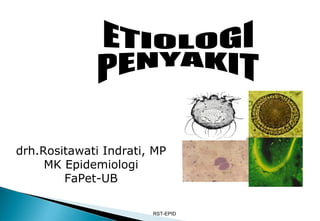Epidemiologi
- 1. drh.Rositawati Indrati, MP MK Epidemiologi FaPet-UB RST-EPID
- 2. RST-EPID ï― The study of the distribution and determinants of health-related states or events in specified populations and the a pplication of this study to the control of h ealth problems (CDC) What is Epidemiology?What is Epidemiology? Pendahuluan
- 3. RST-EPID ï― focused on the health and disease status of a population ï― the study of how disease is distributed in populations and the factors that influence or determine this distribution What is Epidemiology?What is Epidemiology?
- 4. RST-EPID
- 5. RST-EPID Epidemiology is a scientific disciplinediscipline that involves the studystudy of the frequencyfrequency and distributiondistribution of healthhealth and diseasedisease in populationspopulationsin order to find risk factorsrisk factors for preventionprevention and controlcontrol
- 6. RST-EPID 1. Data klinik - Gejala menciri - Status ternak 2. Data labolatori - Patologi - Mikrobiologi - agen/bibit penyakit - penegakkan diagnosa - penunjang penyidikan populasi
- 7. RST-EPID Faktor penyebab penyakit 1. Intrinsik/dalam 2. Ekstrinsik/luar - spesies - pakan - umur - kandang - kelamin - iklim - imunitas Klasifikasi berdasarkan agen/bibit penyakit : 1. Menular/infeksius 2. Non Infeksi - mikroorganisme - trauma - parasit - gangguan metabolism - toksemia/keracunan - neoplasma
- 8. RST-EPID
- 9. RST-EPID Food borne disease dan zoonosis
- 10. RST-EPID Transmisi penyakit 1. Penyebaran : ketahanan induk semang, kesesuaian induksemang predileksi/jar. yang terserang geografis keadaan induk semang tramsmisi 2. Penularan : - kontak langsung (direct contact): kontak seksual,dan kontak fisik sakit dg sehat - kontak tdk langsung (indirect contact) :melalui sekresi (cairan foetal:Bruselosis, Trichomoniasis) atau eksresi (muntahan : Cholera, diare) - makanant tercemar : salmonela sp, cacing intestinal - intermediat hospes: Fasiolasis, Trypanosoma sp
- 11. RST-EPID Berdasarkan penyebabnya: 1. Bakteri : Anthrax, Botulismus, penyakit Ngorok, Infectious Conjungtivitis, Leptospirosis, Tetanus dll 2. Virus : penyakit Mulut dan Kuku,Tetelo Rabies 3. Protozoa : Malaria, Trypanosomiasis, Coccidiosis 4. Parasit : a) Eksterna : Kudis = Skabiosis, Kutu, dan pinjal/caplak b) Interna : cacing hati (Fasciolasis), cacing nematodaToxocara vitulorum , cacing pita (Cisticercosis)
- 12. RST-EPID
- 13. RST-EPID
- 14. RST-EPID âĒTRICHOMONIASIS (T.foetus, abortus trimester I, repeat breeding, pyometra ----- veneral âĒBRUCELLOSIS (B. abortus, 90% abortus trimester akhir â ---- ingestion, veneral) âĒ VIBRIOSIS (Camphylobacter foetus, abortus 3 â 4 bln, 10 - 30% infertil. âĒ IBR (INFECTIOUS BOVINE RHINOTRACHEITIS : 25 â 50% abortus pertengahan kedua kebuntingan ----- aero- sol. âĒ LEPTOSPIROSIS (L pamona, abortus 25-30% trimest 3 kematian foetus) âĒ MICOSIS (Aspergilus absidia, abortus 3-4 bln, placental disease. âĒMastitis yang sepsis/menyebar bersifat zoonosis
- 16. RST-EPID
- 17. RST-EPID
- 18. PEMERIKSAAN 1. Ante mortem : hrs ada surat sehat, surat kepemilikan 2. Post mortem : - Inspeksi - Palpasi - Irisan Bag Kepala leher Isi rongga dada (jantung, paru,) Isi rongga perut Karkas Penularan Penyakit Vertikal horizontal langsung tidak langsung media penularan vektor mekanik daur hidup
- 19. RST-EPID TINJAUAN STUDI EPIDEMIOLOGI â Data : - Prevalensi - Distribusi geografis - Susceptibilitas : umur, bangsa, jenis kelamin - manajemen - Vektor pembawa penyakit Untuk membantu diagnosa : Identifikasi - Laboratorium - Gejala Lapang DIAGNOSA Untuk membantu diagnosa : Identifikasi - Laboratorium - Gejala Lapang Tujuan pengendalian/ Pengobatan yang sesuai DIAGNOSA Pengiriman âsampelâ Segar Awetan
- 20. RST-EPID
- 21. RST-EPID Tentang pengetahuan etiologi penyakit pada ternak, yang hubungannya dengan manajemen peternakan. Sertakan referensinya. TUGASTUGAS Kumpulkan pada akhir kuliah drh. Rositawati I, MP Mengetahui, drh.Rositawati I, MP






















